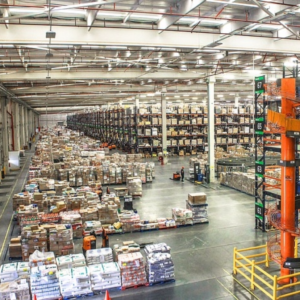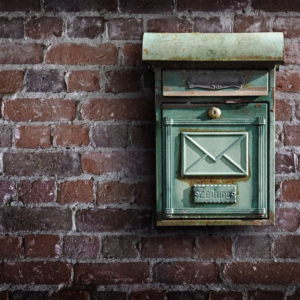Forward-thinking businesses are seeking unified solutions to deliver cost savings, in addition to simplified processes to improve the customer experience across channels. They need a single version of the truth, delivered in real time across the business — from the distribution center to the store; from the call center to the checkout; and from the final purchase channel back to the shopper. These new retail technology trends are the key to providing customers with the commerce experiences they expect.
Transitioning from Commerce Transaction to Customer Loyalty
Where it all starts
 It all begins at the distribution center…the right products need to get to the right stores and shoppers. It is crucial to integrate store inventory and the endless aisle to ensure shoppers get what they want when they want.
It all begins at the distribution center…the right products need to get to the right stores and shoppers. It is crucial to integrate store inventory and the endless aisle to ensure shoppers get what they want when they want.
The biggest challenge for today’s retailers is obtaining real-time inventory visibility into their distribution center (DC) network as well as their stores. Many retail companies now operate multiple DCs in addition to fulfillment from stores, so they need to ask the question:
“When I am fulfilling the need for the shopper, am I fulfilling from the right location?”
For example, if the item is available at a nearby store or DC but gets sent from a DC across the country, the brand may be taking a loss on that item. Losses can add up quickly if the retailer does not get its fulfillment strategy operating efficiently.
With the right solution in place, all stakeholders will have access to real-time inventory visibility and demand planning. By following this retail technology trend of fulfilling from both DC and store, customers are happier and more likely to return fur future purchases.
Less than 50% of retailers have inventory visibility across channels.
The stores: the gateway to customer experience
In a physical store, merchants ensure the best stock positions, as they are able to understand what customers are looking for. On the other hand, store associates and managers are the on-the-ground brand advocates. Armed with the right product information and inventory stock positions, they can provide up-to-date information to shoppers. By leveraging the capabilities of current retail technology trends, employees can cross-sell and upsell merchandise to increase basket size and boost the bottom line based on real shopper data.

A complete commerce solution will offer store employees access to real-time inventory and shopper information via a mobile app — so they don’t need to leave the shopper’s side to gather information. If a product is not available in the store, the associate can access the endless aisle via mobile app to locate the item, process the purchase, and ship or deliver based on the shopper’s preferences.
Cross-selling programs increase an existing customer’s revenue by 25% to 50%.
The best solution also will be proactive — providing alerts as appropriate. Store associates can be informed about buying trends, product reviews, and promotional offers, while the marketing team can utilize alerts to suggest which products to promote on a store, regional, or national level.
The best solutions will be easy to learn and user-friendly, featuring product photos and other images. Finally, the solution will require users to scroll through a minimum number of screens/pages to access a customer’s account or product information.
Individualized customer experiences
Individual shoppers are used to receiving personalized communications through their favorite shopping channels. Shoppers may start on their home PC and move to their mobile device, then re-engage via interactive digital technology in the store.
To be successful in today’s shopper-driven environment, retailers must be able to provide the products and information consumers want via the channel of their choice. To stay relevant in the market, retailers must update stores to meet these current retail technology trends and expectations. But that’s not all: Communication with shoppers must be personalized and relevant, or that shopper will quickly switch to a competitor that delivers the experience they are looking for.
With access to unified commerce, when shoppers get to the store via their channels of choice, associates armed with mobile devices can augment the personalized experience with one-on-one interactions, offering product recommendations and unique promotional offers.
Shoppers now have the ability to uncover the recommendations they typically access online, while they’re in the store. They may want to know: Which accessories did other customers choose with this dress? Were most shoppers who bought this dress happy with the purchase afterward? With a unified commerce solution, that information is readily available to help shoppers pull the trigger on a purchase.
Associates can also pull up previous shopper behavior on their mobile devices to help complete the in-store purchase. For example, if a shopper created a wish list at home on their PC, the store associate can pull up that wish list and fulfill it in-store. The same store associate also can complete an in-store return from an online purchase without leaving the shopper’s side.
Nearly 70% of consumers want in-store recommendations from roving sales associates equipped with mobile devices.
Delivering on what you sell
 It seems easy. Post-purchase, items can be picked up or delivered however the shopper chooses. Inventory information is up-to-date in real time across the entire business, providing employees and customers with accurate information.
It seems easy. Post-purchase, items can be picked up or delivered however the shopper chooses. Inventory information is up-to-date in real time across the entire business, providing employees and customers with accurate information.
However, retailers must be careful not to drop the ball before that last play is made. That play is order pickup and delivery. The best commerce solution will provide real-time inventory updates that help facilitate on-time delivery of the right product, to the right customer at the location he/she desires.
The last step becomes even more important as retailers need to contend with Amazon and other fast-delivery competitors. Shoppers now have more options than ever to receive an order in two days, one day, or even two hours. If they can’t get it when they want it from you, they will head to Amazon Prime or another source to look for the item.
By following the retail technology trend of a unified commerce solution, stores can provide the insights and data required to reduce overall shipping costs and missed delivery dates. For example, a blue sweater may have been shipped from a California DC to a New Jersey shopper’s home, when it would have been much more cost effective, and quicker, to ship from a local New Jersey store.
Same-day delivery options are expected to generate up to $987 million in revenue by 2019.
Loyal customers are driven by unique experiences
Personalization continues to help maintain a healthy relationship with the brand’s most loyal shoppers. Unified commerce can identify shoppers who purchase most frequently, return less frequently, ring up the biggest basket sizes, and refer other loyal customers. They deserve appreciation to keep them coming back.
Once a brand is able to identify its most loyal customers, then it can embrace them with ongoing relevant content, promotional offers, and information that makes the shopper feel valued and part of the brand family. Those communications can be sent immediately post-purchase on the customer’s mobile phone or later in an email. The retailer also can greet the shopper with a personalized message and product recommendations the next time they enter the e-commerce site.
By 2018, companies that have fully invested in all types of personalization will outsell companies that have not by 20%.

It is not just about online greetings; the best shoppers should also be greeted personally during call center interactions. Representatives have real-time access to omnichannel customer data, providing them with enough information to generate meaningful customer experiences.
It’s all about building lasting, long-term relationships with shoppers. A single acceptable experience doesn’t instantly create a loyal customer and brand advocate. To that end, retailers must personalize follow-up communications and provide incentives for customers to come back again and again.
For example, if a shopper purchased a dress recently, the store associate might want to suggest some shoes or jewelry tomorrow; or in a month the retailer may want to let her know a similar item has just arrived. To build the relationship without using an aggressive sales pitch, the retailer may want to send the shopper some videos about how to accessorize, or informational emails about events in her local area.
The best unified commerce solution will provide every shopper with a customized e-commerce site home page that shows items he/she would be interested in based on past purchase behavior.
Unified Commerce Solution
Retail is getting more complicated and challenging every day; and retailers need to be able to adapt to evolving retail technology trends, services, and product offerings when and where they see fit. But with disconnected, outdated solutions in place, retail companies are not ready for the future. The answer, for large and small retailers, is a unified commerce solution.
With a unified solution in place, retailers can feel confident that their brand and business are future-proofed — ready for new channels and technologies, and prepared for growth, both domestically and internationally.

The best strategy is comprehensive — giving retailers a real-time, 360-degree view of shopper behavior from the DC through checkout and beyond. Now, all stakeholders are prepared for success:
- Supply chain executives know where products need to go
- Store managers know how to locate items, whether they are in-stock or available via the endless aisle
- Store associates can deliver vital one-on-one communications with shoppers
- Consumers can receive their orders via the method they choose (in-store pickup, home delivery, etc.)
- Brands can build better personal relationships with the most loyal shoppers post-purchase
To stay relevant, you need to be on the cutting edge. At 3DSMAN we understand retail technology and how it can best serve you and your customers. Contact us today to help you put new technologies in place to bring your business into the future.